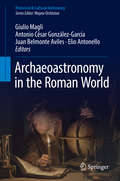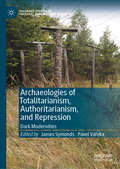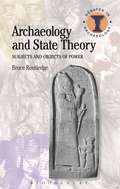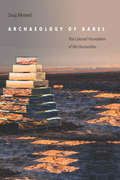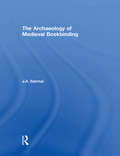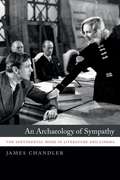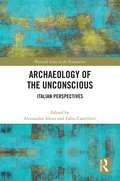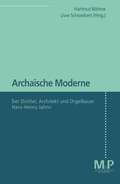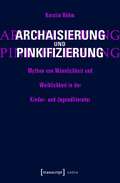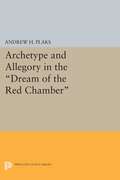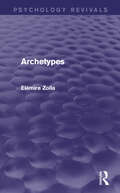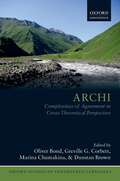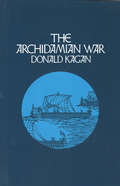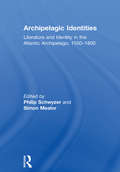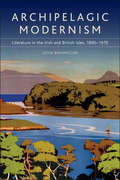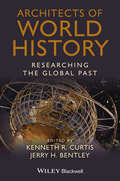- Table View
- List View
Archaeoastronomy in the Roman World (Historical & Cultural Astronomy)
by Giulio Magli Antonio César González-García Juan Belmonte Aviles Elio AntonelloThis book explores the insights that Cultural Astronomy provides into the classical Roman world by unveiling the ways in which the Romans made use of their knowledge concerning the heavens, and by shedding new light on the interactions between astronomy and heritage in ancient Roman culture. Leading experts in the field present fascinating information on how and why the Romans referred to the sky when deciding upon the orientation of particular monuments, temples, tombs and even urban layouts. Attention is also devoted to questions of broader interest, such as the contribution that religious interpretation of the sky made in the assimilation of conquered peoples.When one considers astronomy in the Roman world it is customary to think of the work and models of Ptolemy, and perhaps the Julian calendar or even the sighting of the Star of Bethlehem. However, like many other peoples in antiquity, the Romans interacted with the heavens in deeper ways that exerted a profound influence on their culture. This book highlights the need to take this complexity into account in various areas of research and will appeal to all those who wish to learn more about the application of astronomy in the lives and architecture of the Romans.
Archaeologies of Totalitarianism, Authoritarianism, and Repression: Dark Modernities (Palgrave Studies in Cultural Heritage and Conflict)
by James Symonds Pavel VařekaThis book offers new insights into the mechanisms of state control, systematic repression and mass violence focused on ethnic, political, class, and religious minorities in the recent past. The geographical and temporal scope of the volume breaks new ground as international scholars foreground how contemporary archaeology can be used to enhance the documentation and interpretation of totalitarian and authoritarian regimes, to advance theoretical approaches to atrocities, and to broaden public understandings of how such regimes use violence and repression to hold on to power.
Archaeology and State Theory: Subjects and Objects of Power (Debates in Archaeology)
by Bruce RoutledgeAfter neo-evolutionism, how does one talk about the pre-modern state? Over the past two decades archaeological research has shifted decisively from check-list identifications of the state as an evolutionary type to studies of how power and authority were constituted in specific polities. Developing Gramsci's concept of hegemony, this book provides an accessible discussion of general principles that serve to help us understand and organise these new directions in archaeological research. Throughout this book, conceptual issues are illustrated by means of case studies drawn from Madagascar, Mesopotamia, the Inca, the Maya and Greece.
Archaeology and State Theory: Subjects and Objects of Power (Debates in Archaeology)
by Bruce RoutledgeAfter neo-evolutionism, how does one talk about the pre-modern state? Over the past two decades archaeological research has shifted decisively from check-list identifications of the state as an evolutionary type to studies of how power and authority were constituted in specific polities. Developing Gramsci's concept of hegemony, this book provides an accessible discussion of general principles that serve to help us understand and organise these new directions in archaeological research. Throughout this book, conceptual issues are illustrated by means of case studies drawn from Madagascar, Mesopotamia, the Inca, the Maya and Greece.
Archaeology of Babel: The Colonial Foundation of the Humanities
by Siraj AhmedFor more than three decades, preeminent scholars in comparative literature and postcolonial studies have called for a return to philology as the indispensable basis of critical method in the humanities. Against such calls, this book argues that the privilege philology has always enjoyed within the modern humanities silently reinforces a colonial hierarchy. In fact, each of philology's foundational innovations originally served British rule in India. Tracing an unacknowledged history that extends from British Orientalist Sir William Jones to Palestinian American intellectual Edward Said and beyond, Archaeology of Babel excavates the epistemic transformation that was engendered on a global scale by the colonial reconstruction of native languages, literatures, and law. In the process, it reveals the extent to which even postcolonial studies and European philosophy—not to mention discourses as disparate as Islamic fundamentalism, Hindu nationalism, and global environmentalism—are the progeny of colonial rule. Going further, it unearths the alternate concepts of language and literature that were lost along the way and issues its own call for humanists to reckon with the politics of the philological practices to which they now return.
The Archaeology of Medieval Bookbinding
by J.A. SzirmaiIn the past, studies of the history of bookbinding were mainly concerned with the exterior decoration. This book focuses attention primarily on the physical aspects of the binding and its construction principles. It is an expanded version of a series of lectures delivered by the author while Visiting Professor at the University of Amsterdam in 1987, supplemented with the results of ten years of intensive research in major libraries on the Continent, the United Kingdom and the USA. It surveys the evolution of binding structures from the introduction of the codex two thousand years ago to the close of the Middle Ages. Part I reviews the scanty physical evidence from the Mediterranean heritage, the early Coptic, Islamic and Ethiopian binding structures and their interrelation with those of the Byzantine realm. Part II is devoted to a detailed analysis of Western binding techniques, distinguishing the carolingian, romanesque and gothic wooden-board bindings as the main typological entities; their structure and function is compared with those of contemporary limp bindings. The book is illustrated with over 200 drawings and photographs and contains a comprehensive bibliography.
The Archaeology of Medieval Bookbinding
by J.A. SzirmaiIn the past, studies of the history of bookbinding were mainly concerned with the exterior decoration. This book focuses attention primarily on the physical aspects of the binding and its construction principles. It is an expanded version of a series of lectures delivered by the author while Visiting Professor at the University of Amsterdam in 1987, supplemented with the results of ten years of intensive research in major libraries on the Continent, the United Kingdom and the USA. It surveys the evolution of binding structures from the introduction of the codex two thousand years ago to the close of the Middle Ages. Part I reviews the scanty physical evidence from the Mediterranean heritage, the early Coptic, Islamic and Ethiopian binding structures and their interrelation with those of the Byzantine realm. Part II is devoted to a detailed analysis of Western binding techniques, distinguishing the carolingian, romanesque and gothic wooden-board bindings as the main typological entities; their structure and function is compared with those of contemporary limp bindings. The book is illustrated with over 200 drawings and photographs and contains a comprehensive bibliography.
An Archaeology of Sympathy: The Sentimental Mode in Literature and Cinema
by James ChandlerIn the middle of the eighteenth century, something new made itself felt in European culture—a tone or style that came to be called the sentimental. The sentimental mode went on to shape not just literature, art, music, and cinema, but people’s very structures of feeling, their ways of doing and being. In what is sure to become a critical classic, An Archaeology of Sympathy challenges Sergei Eisenstein’s influential account of Dickens and early American film by tracing the unexpected history and intricate strategies of the sentimental mode and showing how it has been reimagined over the past three centuries. James Chandler begins with a look at Frank Capra and the Capraesque in American public life, then digs back to the eighteenth century to examine the sentimental substratum underlying Dickens and early cinema alike. With this surprising move, he reveals how literary spectatorship in the eighteenth century anticipated classic Hollywood films such as Capra’s It Happened One Night, Mr. Deeds Goes to Town, and It’s a Wonderful Life. Chandler then moves forward to romanticism and modernism—two cultural movements often seen as defined by their rejection of the sentimental—examining how authors like Mary Shelley, Joseph Conrad, James Joyce, and Virginia Woolf actually engaged with sentimental forms and themes in ways that left a mark on their work. Reaching from Laurence Sterne to the Coen brothers, An Archaeology of Sympathy casts new light on the long eighteenth century and the novelistic forebears of cinema and our modern world.
An Archaeology of Sympathy: The Sentimental Mode in Literature and Cinema
by James ChandlerIn the middle of the eighteenth century, something new made itself felt in European culture—a tone or style that came to be called the sentimental. The sentimental mode went on to shape not just literature, art, music, and cinema, but people’s very structures of feeling, their ways of doing and being. In what is sure to become a critical classic, An Archaeology of Sympathy challenges Sergei Eisenstein’s influential account of Dickens and early American film by tracing the unexpected history and intricate strategies of the sentimental mode and showing how it has been reimagined over the past three centuries. James Chandler begins with a look at Frank Capra and the Capraesque in American public life, then digs back to the eighteenth century to examine the sentimental substratum underlying Dickens and early cinema alike. With this surprising move, he reveals how literary spectatorship in the eighteenth century anticipated classic Hollywood films such as Capra’s It Happened One Night, Mr. Deeds Goes to Town, and It’s a Wonderful Life. Chandler then moves forward to romanticism and modernism—two cultural movements often seen as defined by their rejection of the sentimental—examining how authors like Mary Shelley, Joseph Conrad, James Joyce, and Virginia Woolf actually engaged with sentimental forms and themes in ways that left a mark on their work. Reaching from Laurence Sterne to the Coen brothers, An Archaeology of Sympathy casts new light on the long eighteenth century and the novelistic forebears of cinema and our modern world.
An Archaeology of Sympathy: The Sentimental Mode in Literature and Cinema
by James ChandlerIn the middle of the eighteenth century, something new made itself felt in European culture—a tone or style that came to be called the sentimental. The sentimental mode went on to shape not just literature, art, music, and cinema, but people’s very structures of feeling, their ways of doing and being. In what is sure to become a critical classic, An Archaeology of Sympathy challenges Sergei Eisenstein’s influential account of Dickens and early American film by tracing the unexpected history and intricate strategies of the sentimental mode and showing how it has been reimagined over the past three centuries. James Chandler begins with a look at Frank Capra and the Capraesque in American public life, then digs back to the eighteenth century to examine the sentimental substratum underlying Dickens and early cinema alike. With this surprising move, he reveals how literary spectatorship in the eighteenth century anticipated classic Hollywood films such as Capra’s It Happened One Night, Mr. Deeds Goes to Town, and It’s a Wonderful Life. Chandler then moves forward to romanticism and modernism—two cultural movements often seen as defined by their rejection of the sentimental—examining how authors like Mary Shelley, Joseph Conrad, James Joyce, and Virginia Woolf actually engaged with sentimental forms and themes in ways that left a mark on their work. Reaching from Laurence Sterne to the Coen brothers, An Archaeology of Sympathy casts new light on the long eighteenth century and the novelistic forebears of cinema and our modern world.
An Archaeology of Sympathy: The Sentimental Mode in Literature and Cinema
by James ChandlerIn the middle of the eighteenth century, something new made itself felt in European culture—a tone or style that came to be called the sentimental. The sentimental mode went on to shape not just literature, art, music, and cinema, but people’s very structures of feeling, their ways of doing and being. In what is sure to become a critical classic, An Archaeology of Sympathy challenges Sergei Eisenstein’s influential account of Dickens and early American film by tracing the unexpected history and intricate strategies of the sentimental mode and showing how it has been reimagined over the past three centuries. James Chandler begins with a look at Frank Capra and the Capraesque in American public life, then digs back to the eighteenth century to examine the sentimental substratum underlying Dickens and early cinema alike. With this surprising move, he reveals how literary spectatorship in the eighteenth century anticipated classic Hollywood films such as Capra’s It Happened One Night, Mr. Deeds Goes to Town, and It’s a Wonderful Life. Chandler then moves forward to romanticism and modernism—two cultural movements often seen as defined by their rejection of the sentimental—examining how authors like Mary Shelley, Joseph Conrad, James Joyce, and Virginia Woolf actually engaged with sentimental forms and themes in ways that left a mark on their work. Reaching from Laurence Sterne to the Coen brothers, An Archaeology of Sympathy casts new light on the long eighteenth century and the novelistic forebears of cinema and our modern world.
Archaeology of the Unconscious: Italian Perspectives (Warwick Series in the Humanities)
by Alessandra Aloisi Fabio CamillettiIn reconstructing the birth and development of the notion of ‘unconscious’, historians of ideas have heavily relied on the Freudian concept of Unbewussten, retroactively projecting the psychoanalytic unconscious over a constellation of diverse cultural experiences taking place in the eighteenth and nineteenth centuries between France and Germany. Archaeology of the Unconscious aims to challenge this perspective by adopting an unusual and thought-provoking viewpoint as the one offered by the Italian case from the 1770s to the immediate aftermath of WWI, when Italo Svevo’s La coscienza di Zeno provides Italy with the first example of a ‘psychoanalytic novel’. Italy’s vibrant culture of the long nineteenth century, characterised by the sedimentation, circulation, intersection, and synergy of different cultural, philosophical, and literary traditions, proves itself to be a privileged object of inquiry for an archaeological study of the unconscious; a study whose object is not the alleged ‘origin’ of a pre-made theoretical construct, but rather the stratifications by which that specific construct was assembled. In line with Michel Foucault’s Archéologie du savoir (1969), this volume will analyze the formation and the circulation, across different authors and texts, of a network of ideas and discourses on interconnected themes, including dreams, memory, recollection, desire, imagination, fantasy, madness, creativity, inspiration, magnetism, and somnambulism. Alongside questioning pre-given narratives of the ‘history of the unconscious’, this book will employ the Italian ‘difference’ as a powerful perspective from whence to address the undeveloped potentialities of the pre-Freudian unconscious, beyond uniquely psychoanalytical viewpoints.
Archaeology of the Unconscious: Italian Perspectives (Warwick Series in the Humanities)
by Alessandra Aloisi Fabio CamillettiIn reconstructing the birth and development of the notion of ‘unconscious’, historians of ideas have heavily relied on the Freudian concept of Unbewussten, retroactively projecting the psychoanalytic unconscious over a constellation of diverse cultural experiences taking place in the eighteenth and nineteenth centuries between France and Germany. Archaeology of the Unconscious aims to challenge this perspective by adopting an unusual and thought-provoking viewpoint as the one offered by the Italian case from the 1770s to the immediate aftermath of WWI, when Italo Svevo’s La coscienza di Zeno provides Italy with the first example of a ‘psychoanalytic novel’. Italy’s vibrant culture of the long nineteenth century, characterised by the sedimentation, circulation, intersection, and synergy of different cultural, philosophical, and literary traditions, proves itself to be a privileged object of inquiry for an archaeological study of the unconscious; a study whose object is not the alleged ‘origin’ of a pre-made theoretical construct, but rather the stratifications by which that specific construct was assembled. In line with Michel Foucault’s Archéologie du savoir (1969), this volume will analyze the formation and the circulation, across different authors and texts, of a network of ideas and discourses on interconnected themes, including dreams, memory, recollection, desire, imagination, fantasy, madness, creativity, inspiration, magnetism, and somnambulism. Alongside questioning pre-given narratives of the ‘history of the unconscious’, this book will employ the Italian ‘difference’ as a powerful perspective from whence to address the undeveloped potentialities of the pre-Freudian unconscious, beyond uniquely psychoanalytical viewpoints.
Archaisierung und Pinkifizierung: Mythen von Männlichkeit und Weiblichkeit in der Kinder- und Jugendliteratur (Lettre)
by Kerstin BöhmKinder- und Jugendliteratur wird zunehmend nicht mehr nur in Buchform, sondern in Medienverbünden verkauft. Reihen wie »Die Wilden (Fußball-)Kerle« und »Die Wilden Hühner« zeigen zudem eine zweite Verkaufsstrategie der Kinder- und Jugendliteraturproduktion: Sie sind, vor allem im Hinblick auf eine männliche Zielgruppe, offensiv geschlechtsspezifisch adressiert. Kerstin Böhm zeichnet nach, wie diese Reihen im Rahmen des Zusammenspiels von kommerzieller Orientierung und Zielgruppenspezifik mittels Strategien der »Archaisierung« und »Pinkifizierung« Mythen von Männlichkeit und Weiblichkeit tradieren, aber zugleich auch aktualisieren.
Archetype and Allegory in the "Dream of the Red Chamber" (PDF)
by Andrew H. PlaksSurprisingly little has been written in Western languages about the eighteenth- century Chinese novel Dream of the Red Chamber, perhaps the supreme masterpiece of its entire tradition. In this study, Andrew H. Plaks has used the conceptual tools of comparative literature to focus on the novel's allegorical elements and narrative structure. He thereby succeeds in accounting for the work's greatness in terms that do justice to its own narrative tradition and as well to recent advances in general literary theory.A close textual reading of the novel leads to discussion of a wide range of topics: ancient Chinese mythology, Chinese garden aesthetics, and the logic of alternation and recurrence. The detailed study of European allegorical texts clarifies the directions taken by comparable works of Chinese literature, and the critical tool of the literary archetype helps to locate the novel within the Chinese narrative tradition from ancient mythology to the more recent "novel" form. Professor Plaks' innovative use of traditional criticism suggests the levels of meaning the eighteenth-century author might have expected to convey to his immediate audience.This book provides not only an illuminating analysis of this important novel, but also a significant demonstration that critical concepts derived primarily from Western literary models may be fruitfully applied to Chinese narrative works.Originally published in 1976.The Princeton Legacy Library uses the latest print-on-demand technology to again make available previously out-of-print books from the distinguished backlist of Princeton University Press. These editions preserve the original texts of these important books while presenting them in durable paperback and hardcover editions. The goal of the Princeton Legacy Library is to vastly increase access to the rich scholarly heritage found in the thousands of books published by Princeton University Press since its founding in 1905.
Archetypes (Psychology Revivals)
by Elémire ZollaMan is dominated by his archetypes; they mould not only his history but his dreams. But how are we to define and evaluate them? Is it perhaps possible for us to relate more creatively to them? Originally published in 1981, these are some of the questions raised by this title. To answer them the author gathered together a vast amount of material drawn from Eastern and Western traditions, from science, literature, art and poetry. The answers he puts forward are often highly original and will surely challenge many of our most cherished patterns of thought. There emerges from this book what can only be described as a global metaphysical system, yet the author’s language is not that of an ordinary metaphysical treatise, and what he writes offered new challenge and hope to those suffering from the despair and cynicism engendered by a great deal in modern society at the time. Zolla does not, however, advocate a return to earlier historical patterns, nor is he proposing a new Utopia, but rather offers us a brilliant series of lessons in the art of centring. In the words of Bernard Wall, writing in the Times Literary Supplement, Zolla’s ‘deep, polymathic probing of the terms of human existence makes it sensible to compare him with Simone Weil, while some of his conclusions about ultimate mysteries – expressed in signs, symbols and sacraments, the sense of which we have lost – will make us think of the later T. S. Eliot’.
Archetypes (Psychology Revivals)
by Elémire ZollaMan is dominated by his archetypes; they mould not only his history but his dreams. But how are we to define and evaluate them? Is it perhaps possible for us to relate more creatively to them? Originally published in 1981, these are some of the questions raised by this title. To answer them the author gathered together a vast amount of material drawn from Eastern and Western traditions, from science, literature, art and poetry. The answers he puts forward are often highly original and will surely challenge many of our most cherished patterns of thought. There emerges from this book what can only be described as a global metaphysical system, yet the author’s language is not that of an ordinary metaphysical treatise, and what he writes offered new challenge and hope to those suffering from the despair and cynicism engendered by a great deal in modern society at the time. Zolla does not, however, advocate a return to earlier historical patterns, nor is he proposing a new Utopia, but rather offers us a brilliant series of lessons in the art of centring. In the words of Bernard Wall, writing in the Times Literary Supplement, Zolla’s ‘deep, polymathic probing of the terms of human existence makes it sensible to compare him with Simone Weil, while some of his conclusions about ultimate mysteries – expressed in signs, symbols and sacraments, the sense of which we have lost – will make us think of the later T. S. Eliot’.
Archi: Complexities of Agreement in Cross-Theoretical Perspective (Oxford Studies of Endangered Languages #4)
This book presents a controlled evaluation of three widely practised syntactic theories on the basis of the extremely complex agreement system of Archi, an endangered Nakh-Daghestanian language. Even straightforward agreement examples are puzzling for syntacticians because agreement involves both redundancy and arbitrariness. Agreement is a significant source of syntactic complexity, exacerbated by the great diversity of its morphological expression. Imagine how the discipline of linguistics would be if expert practitioners of different theories met in a collaborative setting to tackle such challenging agreement data - to test the limits of their models and examine how the predictions of their theories differ given the same linguistic facts. Following an overview of the essentials of Archi grammar and an introduction to the remarkable agreement phenomena found in this language, three distinct accounts of the Archi data examine the tractability and predictive power of major syntactic theories: Head-driven Phrase Structure Grammar, Lexical Functional Grammar, and Minimalism. The final chapter compares the problems encountered and the solutions proposed in the different syntactic analyses and outlines the implications of the challenges that the Archi agreement system poses for linguistic theory.
The Archidamian War
by Donald KaganThis book, the second volume in Donald Kagan's tetralogy about the Peloponnesian War, is a provocative and tightly argued history of the first ten years of the war. Taking a chronological approach that allows him to present at each stage the choices that were open to both sides in the conflict, Kagan focuses on political, economic, diplomatic, and military developments. He evaluates the strategies used by both sides and reconsiders the roles played by several key individuals.
Archipelagic Identities: Literature and Identity in the Atlantic Archipelago, 1550–1800
by Simon MealorArchipelagic Identities explores the invention and interplay of national, regional and linguistic identities in the literatures of early modern Britain and Ireland. The volume includes innovative work by leading practitioners of British studies, and sheds new light on classic cases such as Edmund Spenser's Irish experience, whilst also introducing less familiar writers and texts, such as Anne Dowriche's The French Historie, William Browne's Britannia Pastorals, William Richards' Wallography, Anne Bradstreet's 'Dialogue between Old England and New', and the works of Gaelic bards and French Huguenot refugees. Foregrounding issues of gender, class and migratory identity which have not previously received significant attention in this field, Archipelagic Identities brings British studies into the mainstream of contemporary literary criticism.
Archipelagic Identities: Literature and Identity in the Atlantic Archipelago, 1550–1800
by Simon MealorArchipelagic Identities explores the invention and interplay of national, regional and linguistic identities in the literatures of early modern Britain and Ireland. The volume includes innovative work by leading practitioners of British studies, and sheds new light on classic cases such as Edmund Spenser's Irish experience, whilst also introducing less familiar writers and texts, such as Anne Dowriche's The French Historie, William Browne's Britannia Pastorals, William Richards' Wallography, Anne Bradstreet's 'Dialogue between Old England and New', and the works of Gaelic bards and French Huguenot refugees. Foregrounding issues of gender, class and migratory identity which have not previously received significant attention in this field, Archipelagic Identities brings British studies into the mainstream of contemporary literary criticism.
Archipelagic Modernism: Literature in the Irish and British Isles, 1890-1970 (Edinburgh University Press)
by John BranniganArchipelagic Modernism examines the anglophone literatures of the archipelago from 1890 to 1970 for what they tell us about changing identities, geographies, and ecologies.
Architects of World History: Researching the Global Past
by Kenneth R. Curtis Jerry H. BentleyArchitects of World History presents an innovative collection of original essays by leading scholars associated with World History, exploring through intellectual autobiography the ideas, challenges, and inspirations that are shaping the field Features original, accessible contributions from pioneering scholars in the field Offers insights into the process of developing a workable world history research topic and the experience of professional life as a world historian. Points to methodological challenges; the scholar’s current research agenda in relation to the development of world history; and future directions anticipated for key areas within world history
Architects of World History: Researching the Global Past
by Kenneth R. Curtis Jerry H. BentleyArchitects of World History presents an innovative collection of original essays by leading scholars associated with World History, exploring through intellectual autobiography the ideas, challenges, and inspirations that are shaping the field Features original, accessible contributions from pioneering scholars in the field Offers insights into the process of developing a workable world history research topic and the experience of professional life as a world historian. Points to methodological challenges; the scholar’s current research agenda in relation to the development of world history; and future directions anticipated for key areas within world history
